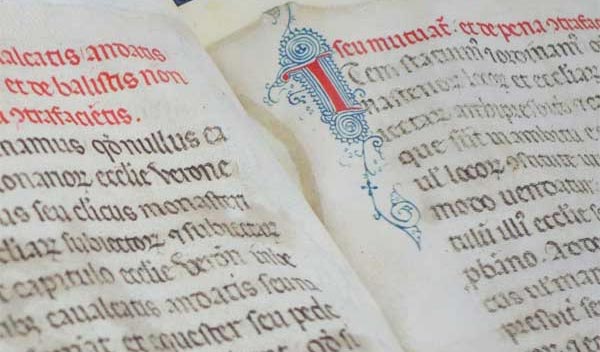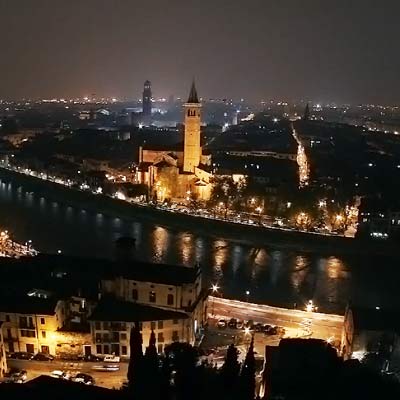Modern Art Gallery
The Modern Art Gallery of Verona brings together in a single location the Achille Forti collection and a selection of the Fondazione Domus collections. The exhibition covers a period that goes from the mid-19th to the mid-20th century, with works by the great artists of the Italian avant-garde and thematic areas linked to the city of Verona. The exhibition venue is Palazzo della Ragione, an ancient medieval public building.

Our tour guides, always active in the promotion of the attractions of Verona, with its events and exhibtion, will accompany you on a guided tour of Palazzo della Ragione and the Modern Art Gallery, also as a complement to one of the many guided tours of Verona.
Oncoming Tours
The Exhibtion
Views of Verona
The exhibition opens with an introduction to nineteenth-century Verona through city scenes, painted views and the first black and white photographs. These works offer a testimony of the places, characters and atmospheres of the 19th century and how buildings and monuments have changed. In this section Baldassarre Longoni with "Verona from Castel San Pietro", Alfredo Savini "Fishermen at Garda", Giulio Trentini "The pearls of the lake".
Dante's Monument

Particularly significant for the history of the city is the sketch of the statue of Dante's monumentcreated by sculptor Ugo Zannoni. In a Veneto still under the Austro-Hungarian domination, making a public monument to Dante, father of the language of a country of which Verona was not a part of, had a strong patriotic and nationalistic value and could have cost the promoters dearly.
The finished statue was placed in piazza dei Signori, just in front of Palazzo della Ragione, seat of the Modern Art Gallery.
Risorgimento (Italian Independence Movement
The famous "Meditation" by Francesco Hayez is also part of the great political involvement of Italian artists in the 19th century. Also in these first rooms is the painting "Carlotta Aschieri killed by the Austrians on 6 October 1866" by Pietro Rossi, Giovanni Fattori with "Grande manovre", which continues the patriotic commitment.
Even the sketch for the monument to Paolo Veronese by Torquato della Torre is placed in a dimension of rediscovery of Verona and its glorious history in the aftermath of annexation.
Early '900s
Verona in the late nineteenth and early twentieth century, until the years leading up to the I World War, lived a moment of extraordinary happiness and lightheartedness that transmitted in the arts, with the birth of the opera festival at the Arena, in architecture with the liberty and decò style by Ettore Fagiuoli, and with the development of a bourgeoisie that pursued modernity and renovation.
The first European avant-gardes, such as Impressionism, Symbolism and Pointillism, were introduced to Verona by artists like Angelo Dall'Oca Bianca, who blended the new styles in subjects linked to tradition and local customs.

"Stelle Cadenti" - by Angelo Dall'Oca Bianca
Forerunners of the more typically Italian twentieth century include Portrait of Teresa Mandinelli by Felice Casorati, Guido Trentini with The Red Plant, Umberto Boccioni, who died and is buried in Verona, Balla, Pio Semeghini, and Gino Rossi.
The Avant-gards
In the wake of the Great War we see the explosion of the avant-gardes with Ardengo Soffici "Collage", Gino Severini, Augusto Mansini "Winter Morning", "View of Ponte Pietra", Rovato Righetti surnamed Di Bosso, "The Parachutist" in the typical aeropittura style, contrasted by the search for classicist roots in the works of Giorgio De Chirico "Watermelons with armor and landscape" of 1924, Alberto Savinio "The Marine Poem", "The good Friday" and again Cagnaccio di San Pietro "Allo specchio" and "Maternity II" with the change in visual poetics leading progressively to the Italian '900 and the magical realism of Ubaldo Oppi "Ragazzo cadorino", "The Three Surgeons" and the splendid "Juggler" by Antonio Donghi.
Second Postwar period
From there, we move on again to the subsequent breakdown of the forms with Marino Marini "Cavaliere", Filippo De Pisis, Arturo Martini "Donna che nuota sott'acqua".
The crisis of Italian monumentalism is contrasted by Pino Casarini, decorator, set designer, whose traces can be found throughout the Verona of the '900, with his "Disfida di Barletta".
Informal Style
In the last rooms an overview of authors of the Italian informal period with works by Vedova, Capogrossi, Crippa, etc..
Display
The choice and arrangement of the works is designed to create a comparison between opposing artistic movements within the same time span, with a contrast between the avant-garde and the more classical and formal styles. From this emerges the role that Verona has often played in the scenario of art history, even in the contemporary sphere. Although Verona has almost always been a provincial city, its position and characteristics have often enabled it to maintain its own artistic and cultural independence and originality.
Rotations
The exhibition will have its own structure with some works that will form the backbone but will be animated by changes and loans that will help keep it alive and changing.
Palazzo della Ragione

The same exhibition environment of the Gallery of Modern Art helps to further strengthen its close ties with Verona. The Palazzo della Ragione is in fact one of the oldest buildings in the city (excluding of course the roman monuments), among the oldest public buildings in Italy. It was built in the mid 1100s, combining pre-existing medieval buildings into a single project. It served as the seat of the town hall, market and tribunal of Verona until the 1980s. After a long period of neglect it was finally restored with an intervention by Afra and Tobia Sccarpa, children of the great Carlo Scarpa, turning into a multipurpose exhibition center. The restoration was carried out in the wake of the guidelines drawn by Carlo Scarpa that in Verona has left its mark with his famous restoration of Castelvecchio, often combining very modern and minimal elements to the ancient architecture, thus creating a contrast that highlights the charm of the building.
The Palazzo della Ragione is a great example of Romanesque architecture, with the typical alternation of tuff and brick. Over the course of the centuries, the building has undergone many alterations and reconstructions, such as the internal Renaissance arches, the composite staircase, the neoclassical facade overlooking Piazza delle Erbe, and the magnificent Notaries' Chapel, a triumph of 18th-century Veronese art.
Lamberti Tower
The complex is completed by the Torre dei Lamberti, the ancient municipal tower, still the tallest building in Verona, which is part of the palace. With a single ticket, it is possible to visit both the Lamberti Tower, by taking the elevator up to the panoramic terrace, and the exhibition.
Cappella dei Notai

The palace itself would be reason enough for a visit. There you can admire the imposing interior colonnade, with triumphal arch and huge serliana, built in '500 by a workshop certainly very close to Michele Sanmicheli. The masterpiece of the palace is, however, the spectacular Cappella dei Notai, a small jewel of the '700 richly decorated with vaulted ceilings, works of high woodwork and the impressive paintings of Louis Dorigny that depict the exorcisms of San Zeno.

For more information and details on the Verona Modern Art Gallery and onguided tours of the exhibition and Verona:
Enquiries and Bookings:
+39 333 2199 645 info@veronissima.com P.I. 03616420232 C.F. CPPMHL74L13L781C

 IT
IT 日本
日本 DE
DE FR
FR 中文
中文 ES
ES











